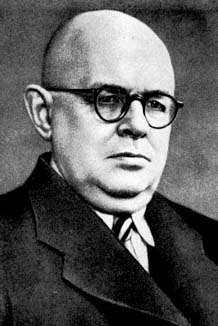Anton Sushkevich
Anton Kazimirovich Sushkevich (Антон Казимирович Сушкевич) (23 January 1889, Borisoglebsk, Russia — 30 August 1961, Kharkiv, Ukraine) was a Russian mathematician and textbook author who expanded group theory to include semigroups and other magmas.
Anton Kazimirovich Suschkewitsch | |
|---|---|
 | |
| Born | 23 January 1889 Borisoglebsk, Southern Russia |
| Died | 30 August 1961 |
| Alma mater | Berlin University, St Petersburg University, Kharkov University |
| Known for | First semigroup-theorist in the world |
| Scientific career | |
| Fields | Mathematician |
| Institutions | Kharkov University |
Sushkevich attended secondary school in Voronezh and studied in Berlin from 1906 to 1911. There he attended lectures of F. G. Frobenius, Issai Schur, and Hermann Schwarz. Sushkevich studied piano with L. V. Rostropovich, father of Mstislav Rostropovich. In 1906 he was a cello student at Stern Conservatory (now part of Berlin University of the Arts). In 1911 he moved to Saint Petersburg, graduating from the Imperial University in 1913.
Moving to Kharkiv, Suskevich taught in secondary education while he pursued a graduate degree at Kharkov State University. His dissertation was The theory of operations as the general theory of groups. Obtaining the degree, he became an assistant professor at the university in 1918, and adjunct professor in 1920. Voronezh State University employed Sushkevich in 1921 as professor of mathematics. He published the first edition of his Higher Algebra (1923). He published a generalization of Cayley's theorem for certain finite semigroups in 1926.[1] The next year he was in Moscow for the Russian Mathematical Congress, and the following year in Bologna for the International Congress of Mathematicians.
In Kharkiv, the Ukrainian Scientific Research Institute of Mathematics and Mechanics was established in 1929 with Sushkevich as a member. With a rising interest in abstract algebra, he wrote a second book on algebra: Foundations of Higher Algebra which was published both in Russian and Ukrainian. In 1933 he directed the Algebra & Number Theory section of Kharkov State University's department of mathematics. At that time Stalin caused a famine in Ukraine, the Holodomor, killing millions especially in rural areas. Suskevich survived to edit new editions of his textbook that included "new algebra": fields, integral domains, rings, ideals, and quaternions. His original work, The Theory of Generalized Groups (1937) opened up the area of semigroups. According to biographer Hollings, "He sought to describe his semigroups of interest in terms of certain of their subgroups: from Sushkevich's point of view, groups were objects of known structure."[2]:46
Selected works
- 1928: "Über die endlichen Gruppen ohne das Gesetz der eindeutigen Umkehrbarkeit", Mathematische Annalen, 99 (1): 30–50, doi:10.1007/BF01459084, hdl:10338.dmlcz/100078, ISSN 0025-5831, MR 1512437.
- 1929: "On a generalization of the associative law", Transactions of the American Mathematical Society 31(1):204–14 doi:10.1090/S0002-9947-1929-1501476-0 MR1501476
- 1951: "Materials for the History of Algebra in Russia in the 19th and beginning of the 20th centuries", MR00051749
- 1954: Theory of Numbers, second edition 1956 MR0091286
References
- A. Sushkevich (1926) "Über die Darstellung der eindeutig nicht umkehrbaren Gruppen mittels der verallgemeinerten Substitutionen", Matematicheskii Sbornik 33: 371–4
- Christopher Hollings (2014) Mathematics Across the Iron Curtain: A History of the Algebraic Theory of Semigroups, chapter 3: Anton Kazimirovich Sushkevich, pages 45 to 76, American Mathematical Society, ISBN 978-1-4704-1493-1 MR3494795
- Christopher Hollings (2009) "The early development of the algebraic theory of semigroups", Archive for History of Exact Sciences 63(5): 497–536, especially 511–513.
- O'Connor, John J.; Robertson, Edmund F., "Anton Sushkevich", MacTutor History of Mathematics archive, University of St Andrews.
- Christopher Hollings Summary of "Finite groups without unique invertibiility" (PDF) via WebCite